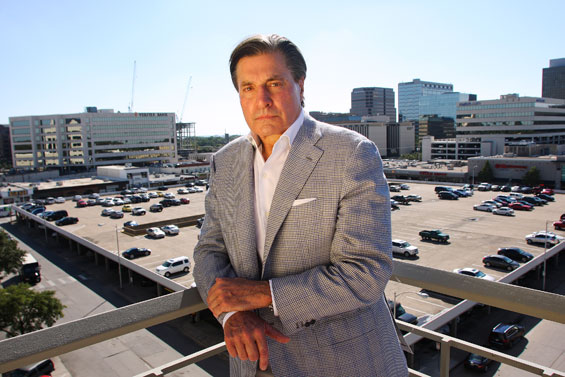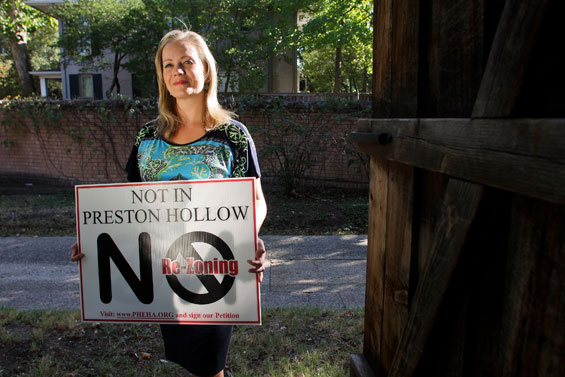The Battle for Preston Hollow's Soul
Luke Crosland stands at the window of his seventh-floor office and looks out across Preston Center. In the foreground, a tangle of luxury SUVs battle for access to a shabby, two-story parking garage that seems to deteriorate before his eyes. The garage is ringed by a jumble of aging retail strips that wouldn't be out of place in a working-class neighborhood in Garland. Further back, past the Marshalls, a clump of mid-rise office towers stand as a testament to a 1980s office boom.
Mark Graham Luke Crosland has been trying -- and failing -- to redevelop Preston Center for years.
Crosland is a pugnacious commercial real estate developer best known for the iLume apartments on Cedar Springs Road. He's been gazing down on this scene since he bought into Preston Center 27 years ago. There are trendy new restaurants like John Tesar's Spoon and Hopdoddy Burger Bar, and a few office buildings have gone up here and there, but the difference between now and then is cosmetic. The retail buildings are still outdated. The infrastructure is still crumbling. Three decades of decay have only made the situation worse.
It's a disgrace, Crosland mutters with a mournful shake of the head. Here, Preston Hollow and the Park Cities converge with two of Dallas' busiest streets and the bustling Dallas North Tollway to form an unimaginably rich vein of real estate wealth. There should be an appropriately upscale mix of shops, offices and apartments. Instead, he says, there's a strip center better suited to Des Moines.
Actually, no, that's not fair. A U.S. capital, even Iowa's, is too generous a comparison. Peoria, he decides. Preston Center is like something from Peoria.
It's not just Preston Center. The entire Preston Road/Northwest Highway intersection is
curiously underwhelming given the vast sea of money it floats upon, as if real estate icon Ebby Halliday had pressed a pause button when she moved her headquarters here in the mid-1960s. To the northeast, formerly grand condominiums built in the '50s and '60s decay behind the once-celebrated "pink wall," which a half century of sun and car crashes has left a scarred and splotchy beige. The northwest corner is Ebby's. The little white house that houses her real estate office is a jarring throwback to the 1920s, when developer Ira Deloache built it for his headquarters. She lives in an estate next door. The shopping center on the southeast corner is markedly fancier but still feels cut from an earlier era.
Developers have been lusting after these corners for decades, but their advances have been held at bay by various factors -- zoning restrictions, the splintered ownership of Preston Center and the area behind the pink wall, probable opposition from neighbors. Recently, though, it's been thrust into the middle of a battle for Dallas' soul.
Dallas is, at heart, less an urban area than a conglomeration of sprawling, suburban-style neighborhoods. Most of the city was developed after World War II, when a highway-building craze and the ubiquity of the car fueled speculators to gobble up cheap tracts of land on the increasingly distant fringe and plant subdivisions. North Dallas in particular became a sea of sturdy brick homes distinguished more by the names their developers bestowed -- Midway Hollow, Sparkman Club Estates, The Meadows -- than by any variation in their ranch-style architecture.
Embracing this pattern of development has left the city in a bind. The speculators moved on to Richardson, then Plano, then Frisco and beyond. Dallas, meanwhile, is stuck with the bill for maintaining the sprawling infrastructure necessary to support a city that treats four bedrooms and a professionally manicured backyard as a birthright. The costs could be met if Dallas' population and tax base grow fast enough, but they haven't. Over the last decade, while the rest of North Texas has boomed, Dallas has stagnated. Its population has barely budged and it's hemorrhaged tens of thousands of jobs as employers have followed their workers out of Dallas.
The solution is to make Dallas more dense. Build places where people don't have to get in their cars and cross six lanes of traffic to buy a gallon of milk or waste an hour commuting to work. The suburbs will always be cheaper and newer, but a large, dense population center offers a vibrancy and connectivity the suburbs can't, attributes many people, especially young people, will trade for a white picket fence. Uptown is proof.
For Dallas, the question is how to balance that density with the interests of the single-family neighborhoods that blanket the vast majority of the city's developable land. Should apartments and condo towers be relegated as they currently are to areas that are already dense (downtown), depopulated industrial areas (the Design District and the Cedars) or politically disenfranchised minority neighborhoods (Trinity Groves)? Or should the city encourage density -- well planned and intelligently done -- even when nearby homeowners might object?
The debate came into particularly sharp focus earlier this year when Crosland and commercial real estate developer Transwestern separately rolled out plans to plant large apartment projects at Preston and Northwest Highway. Crosland, gazing down from this seventh-floor perch, saw his project as a catalyst. He imagined a future version of Preston Center, presided over by his apartment tower, pulsing with the vibrancy of Uptown. First, though, he would have to convince Dallas to allow an apartment high-rise in Preston Center. And he would have to do so over the objections of wealthy and powerful Preston Hollow homeowners -- including former Mayor Laura Miller -- who would fight, sometimes fairly and sometimes not-so, to preserve the ugly status quo on the other side of Crosland's glass.
Preston Hollow East, bounded generally by Northwest Highway, Preston Road, Walnut Hill Lane and Hillcrest Road, is the quintessential North Dallas neighborhood: a neat grid of quiet, tree-lined streets and spacious lots populated by successful doctors and lawyers and bankers. It lacks something of the grandeur of the lush millionaires' estates of Old Preston Hollow that ramble to the west of Preston Road, and it's missing the prestige of the University Park addresses south of Northwest Highway, but it straddles the line where upper-middle-class blurs into unapologetic wealth.
Mark Graham Ashley Parks helped slay a residential project behind Northwest Highway's "pink wall."
Ashley Parks is a child of the neighborhood. She grew up on Deloache Avenue, so named for the man who developed Preston Hollow, and was charmed by how peaceful and tight-knit it seemed. Circumstances forced her to spend a dozen years in exile: Her family moved to a new neighborhood two miles to the north in 1989, when Parks was in the eighth grade, and she spent four years at Texas A&M University and a few more living Uptown while she established her financial planning career and settled into adult life. But she always planned to return as soon as possible.
Her opportunity came in 2002, a year after she married an SMU-trained corporate lawyer named James Parks III. Home prices still hadn't recovered from the dot-com bubble's burst, and the couple found a deal on an aging but sturdy three-bedroom brick home on Del Norte, with a swimming pool in back and two magnolia trees shading the front. It was far from perfect -- a row of gargantuan shrubs is all that separates it from bustling Preston Road -- but it possessed the same idyllic charm Parks remembers from her youth.
Parks was a freshman at A&M when her future neighbors felled their first developer. In the spring of 1995, plans were unveiled to raze 144 apartments at the corner of Northwest Highway and Turtle Creek Boulevard to make way for a Tom Thumb-anchored strip center. Homeowners rebelled. Several hundred of them packed Preston Hollow Elementary one February evening to denounce the plan. A week later, it was dead.
The fight unified neighbors and reinvigorated the long-dormant Preston Hollow East Homeowners Association, which has remained an active organization even though the development fights have been few and far between. By the time Parks assumed the presidency in 2011, its energies had long been focused on more mundane tasks -- crime watch patrols, neighborhood get-togethers, West Nile-prevention tips. But the outrage that fueled the 1995 fight never really went away. More like it settled into a state of hibernation, ready to be awakened the next time a developer dared to give it a nudge.
The nudge came late last December, when Parks learned from people living behind the pink wall that Transwestern, a Houston-based behemoth of commercial real estate, had been pitching condo owners on a plan to build an eight-story luxury apartment complex on the corner of Preston and Northwest Highway. Parks called Sarah Dodd, a TV reporter-turned-PR consultant representing Transwestern, and demanded an explanation.
"We met at the Corner Bakery, and she's like 'Look! Look at these amazing plans!'" Parks recalls. "And she showed them to me and I was like, 'My pool! My backyard is in your plans!' -- Literally, my whole pool was there."
Not included in the plans, though Parks needed no help envisioning them, were a gaggle of divorced dads (among Transwestern's target demographics) leering down from their eighth-floor balconies as she and her 7-year-old daughter went for a swim.
After the meeting, Parks sent an email blast to Preston Hollow East HOA members describing her meeting with Dodd. Her neighbors didn't need the prospect of being ogled by middle-aged men to be against the project. "Once everybody heard about this, they were like, 'What do we do? How do we stop this?'" Parks says.
Parks and about 100 of her neighbors filed into the Black-Eyed Pea in Preston Center on the morning of January 25 for a meeting with Transwestern and City Council member Lee Kleinman. Jennifer Staubach Gates, the council member who represents the neighborhood, had appointed Kleinman after recusing herself because her father, Cowboys legend Roger Staubach, and her husband, John Gates, both work for Jones Lang Lasalle, a real estate firm involved in the Transwestern deal.
Transwestern had met with dozens of condo owners, but this was the first face-to-face get-together with the single-family homeowners to the north. Mark Culwell, a senior vice president at Transwestern, opened the meeting with a quick overview of the project: 296 high-end, two- and three-bedroom units, each renting for $2,000 to $5,000 per month to a target market of empty nesters with six-figure incomes. The development would replace the dozen townhomes of Townhouse Row and the small, corrugated-metal-draped apartment complex next door. It would consist of two buildings, vaguely Mediterranean in style, one on either side of Averill Way, stair-stepping from four stories on the north, next to Parks' house, to eight stories along Northwest Highway.
Neighbors were civil but skeptical. They worried that packing 500-plus people onto three acres at the edge of their neighborhood would spoil Preston Hollow East's close-knit feel. The traffic generated by those new residents, plus their visitors, housekeepers and moving vans, would further clog the intersection of Preston and Northwest Highway, they said. Some might careen dangerously down the neighborhood's quiet streets. One homeowner asked if the apartments would welcome low-income residents through HUD vouchers. The answer was no, but Culwell's repeated assurance that Transwestern was catering to rich people did nothing to quell concerns that the development would quickly spiral downward, inviting crime and blight to Preston Hollow's doorstep.








































